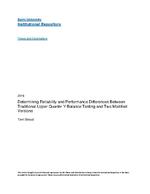|
|

Notes
- Abstract:
- Background: While the Upper Quarter Y-Balance Test (UQYBT) has been proven to be a reliable testing tool for young and healthy individuals, not all populations have been discussed in research. Older adults and individuals who are overweight/obese and their performance on the UQYBT has been from research thus far. This lack of research may be related to the difficulty that they may have in performing the test in its current format. Methods: A sample of healthy students of collegiate age, twenty-five (9 men, 16 women; mean ages 24.4 ± 3.3 and 23.6 ± 3.3 years), performed three variations of the UQYBT. Performance on these tests were assessed to determine the reliability of the two modifications and scores differences between the three UQYBTs variations. Results: Findings revealed consistency for the two UQYBTs modifications, in all three reach directions, based on Cronbach’s Alpha values. To determine the effect of the three UQYBT positions on the composite reach scores for each side, two separate one-way repeated measures ANOVA tests were performed. A follow-up paired sample t-test was conducted if a significant main effect was found with an alpha level of 0.05 being used to determine significance level. There was also shown to be significant main effects for composite scores on the right (F(2, 72), = 6.19, p = 0.003) and left (F(2, 72), = 4.12, p = 0.004) sides. Post-hoc analysis revealed that the standing UQYBT composite score was significantly higher for both sides than modified and traditional UQYBT composite scores (p < 0.05). The modified UQYBT composite scores, for both sides, were significantly higher than traditional UQYBT composite scores (p < 0.05). Discussion: The UQYBT has already proven to be a reliable tool for measuring shoulder stability and mobility. Because of the consistency found between all testing positions and the high reliability found for the modified versions, it appears that the UQYBT’s modified and standing positions may be suitable for older adults and overweight/obese populations who may have difficulty holding themselves up during traditional testing. Future research is needed to determine applicability in these populations.
- Thesis:
- Thesis (M.S.)--Barry University, 2019.
- Bibliography:
- Includes bibliographical references (leaves 39-44 ; 62-64).
Record Information
- Source Institution:
- Barry University
- Holding Location:
- Barry University Archives and Special Collections
- Rights Management:
- Copyright Terri Stroud. Permission granted to Barry University to digitize, archive and distribute this item for non-profit research and educational purposes. Any reuse of this item in excess of fair use or other copyright exemptions requires permission of the copyright holder.
- Resource Identifier:
- RD557.5.S77 2019_StroudTerri ( BU-Local )
- Classification:
- RD557.5.S77 2019 ( lcc )
|
|